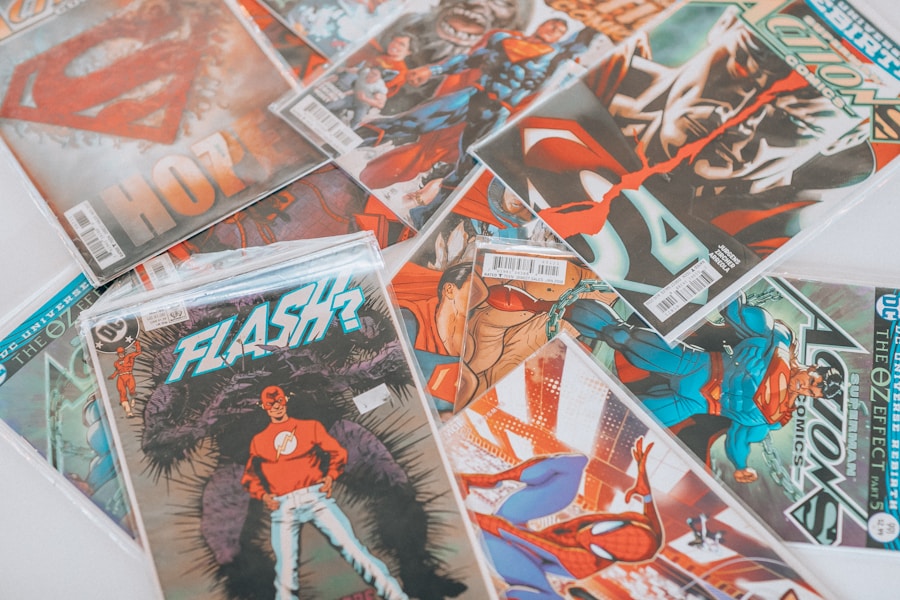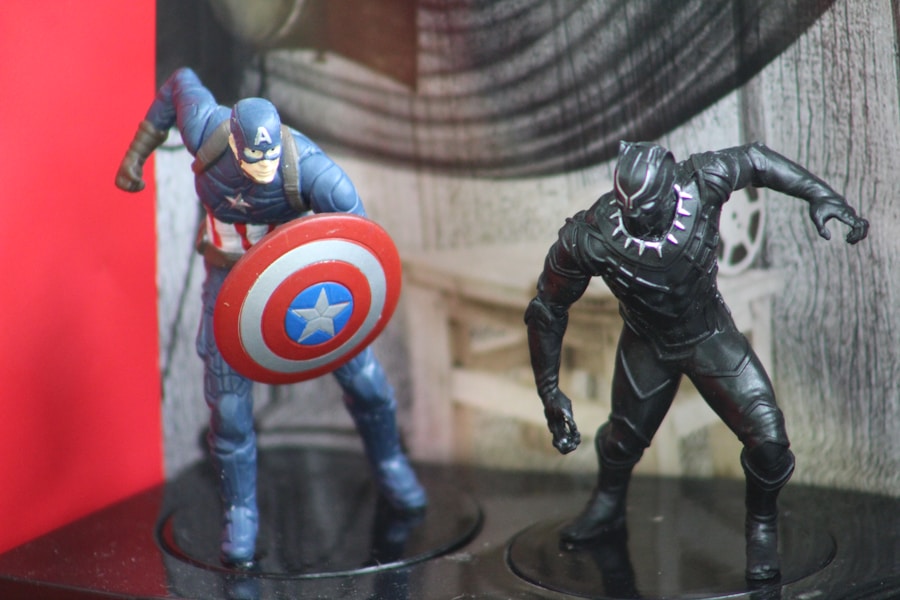In the realm of comic books, two titans stand tall: Marvel and DC Comics. These two companies have not only shaped the comic book industry but have also become cultural phenomena that extend far beyond the pages of their publications. As a fan or a casual observer, you may find yourself drawn into the ongoing debate about which company reigns supreme.
Is it Marvel, with its interconnected cinematic universe and relatable heroes, or DC, with its iconic characters and darker narratives? This article will delve into various aspects of both companies, from sales figures to cultural impact, to help you navigate this complex landscape and form your own opinion. The rivalry between Marvel and DC is not just about who has the better superheroes; it’s a multifaceted competition that encompasses storytelling, character development, and even the way each company engages with its audience.
As you explore this article, you’ll gain insights into how these two giants have evolved over the years and how they continue to influence not just comic book readers but also the broader entertainment industry. By the end, you’ll have a clearer understanding of what sets these two companies apart and perhaps even a newfound appreciation for both.
Key Takeaways
- Marvel and DC Comics have been long-standing rivals in the comic book industry, each with their own unique universe of superheroes and villains.
- While DC Comics has historically sold more comic books, Marvel has seen a surge in sales in recent years, especially with the success of their cinematic universe.
- In terms of critical acclaim, both Marvel and DC have received praise for their comic book series, with each company having their own standout titles and storylines.
- The cultural impact of Marvel and DC Comics is undeniable, as both have influenced pop culture through their iconic characters, storylines, and adaptations.
- Marvel and DC both have dedicated fan bases, with each company’s fans showing strong loyalty and engagement, whether through comic book sales, movie ticket purchases, or fan conventions.
When it comes to sales figures, Marvel has often taken the lead in recent years. The company’s ability to create blockbuster films that resonate with audiences has translated into increased comic book sales. You might be surprised to learn that Marvel’s strategic marketing and cross-promotion with its cinematic universe have significantly boosted its comic book sales.
For instance, when a new Marvel movie hits theaters, it often coincides with the release of related comic book issues, enticing fans to dive deeper into the source material. This synergy between film and comics has proven to be a winning formula for Marvel. On the other hand, DC Comics has its own strengths that contribute to its sales figures.
While it may not always match Marvel’s numbers, DC has a rich legacy of iconic characters like Superman, Batman, and Wonder Woman that continue to attract readers. You may find that DC’s graphic novels and trade paperbacks often perform exceptionally well, especially among collectors and casual readers who prefer complete story arcs over single issues. The company’s focus on high-quality storytelling and artistic innovation has allowed it to maintain a loyal customer base, even in a competitive market.
Ratings Comparison: Which Company Receives Better Critical Acclaim?
Critical acclaim is another area where both Marvel and DC have their strengths. Marvel has garnered praise for its character-driven narratives and humor, particularly in its cinematic adaptations. You might recall how films like “Black Panther” and “Spider-Man: Into the Spider-Verse” received accolades not just for their box office success but also for their storytelling and cultural significance.
Critics often highlight Marvel’s ability to blend action with emotional depth, making its characters relatable and engaging. Conversely, DC has made significant strides in recent years, particularly with its graphic novels and animated features. Titles like “Batman: The Killing Joke” and “Wonder Woman: Dead Earth” have received critical acclaim for their mature themes and artistic innovation.
You may find that while DC’s films have had mixed reviews, its animated series and graphic novels often resonate deeply with audiences and critics alike. The company’s willingness to tackle complex issues through its storytelling sets it apart in the eyes of many critics.
Cultural Impact: How Marvel and DC Have Influenced Pop Culture

The cultural impact of Marvel and DC cannot be overstated. Both companies have created characters that have become household names, influencing everything from fashion to language. You might notice how phrases like “With great power comes great responsibility” have permeated popular culture, originating from Spider-Man’s lore.
Marvel’s characters often embody themes of resilience and hope, resonating with audiences across generations. DC, on the other hand, has contributed significantly to the darker aspects of superhero narratives. Characters like Batman explore themes of justice, morality, and the human condition in ways that challenge readers to think critically about societal issues.
You may find that DC’s influence extends beyond comics into literature, film, and even philosophy, as its stories often provoke deeper discussions about ethics and morality. Both companies have left indelible marks on pop culture, shaping how we view heroes and villains in our everyday lives.
Fan Base: Analyzing the Loyalty and Engagement of Marvel and DC Fans
When it comes to fan engagement, both Marvel and DC boast passionate communities that are fiercely loyal to their respective brands. You might find that Marvel fans often celebrate their favorite characters through cosplay at conventions or by participating in online forums dedicated to discussing plot theories and character arcs. The sense of community among Marvel fans is palpable, fueled by the interconnectedness of its cinematic universe that encourages discussions about upcoming films and storylines.
DC fans also exhibit a strong sense of loyalty, often rallying around their favorite characters in unique ways. You may notice that DC fans tend to appreciate the depth of storytelling in graphic novels and animated series, leading to a different kind of engagement compared to their Marvel counterparts. The diversity within DC’s character roster allows for various interpretations and discussions among fans, creating a rich tapestry of opinions and theories that keep the community vibrant.
Diversity and Representation: Examining the Inclusivity of Marvel and DC Comics
Diversity and representation are crucial topics in today’s comic book landscape, and both Marvel and DC have made strides in this area.
These characters not only reflect contemporary society but also resonate with younger audiences who seek representation in their heroes. DC has also made significant efforts toward inclusivity by introducing characters like John Stewart as Green Lantern and Jessica Cruz as a newer iteration of the character. You may find that both companies are increasingly aware of their responsibility to represent various cultures, genders, and identities within their narratives.
This commitment to diversity enriches the storytelling experience for readers who see themselves reflected in these characters.
Adaptations: Comparing the Success of Marvel and DC Movies and TV Shows

The success of adaptations is another critical area where Marvel has often outperformed DC in recent years. The Marvel Cinematic Universe (MCU) has become a cultural juggernaut, with films consistently breaking box office records. You might recall how movies like “Avengers: Endgame” became monumental events that brought fans together worldwide.
The interconnected nature of the MCU allows for a cohesive storytelling experience that keeps audiences engaged across multiple films. In contrast, while DC has had its share of successful adaptations—such as “Wonder Woman” and “Aquaman”—it has struggled with consistency in its cinematic universe. However, you may find that DC’s animated series have garnered critical acclaim for their storytelling quality.
Shows like “Batman: The Animated Series” set a high standard for superhero animation, proving that while DC may face challenges in live-action adaptations, it excels in other formats.
Which Company Comes Out on Top?
As you reflect on the various aspects discussed throughout this article, it becomes clear that both Marvel and DC have unique strengths that appeal to different audiences. While Marvel may lead in sales figures and cinematic success, DC offers rich storytelling and iconic characters that resonate deeply with fans. Ultimately, determining which company comes out on top depends on your personal preferences as a reader or viewer.
In this ongoing rivalry between Marvel and DC, there is no definitive answer; both companies contribute significantly to the comic book industry and pop culture at large. Whether you lean towards the humor and relatability of Marvel or appreciate the depth and complexity of DC’s narratives, there is no denying that both have shaped our understanding of heroism in profound ways. As you continue your journey through this vibrant world of comics, remember that both companies offer something valuable—each with its own unique flavor that enriches your experience as a fan.
If you’re a fan of Kaiju and looking for more in-depth analysis and recommendations, you should check out The Ultimate Guide to the Top Godzilla Books You Must Read. This article provides a comprehensive list of must-read books for any Godzilla enthusiast, offering valuable insights and recommendations for further exploration of the Kaiju genre.
FAQs
What is the article “Is Marvel Better Than DC Comics? Data-Driven Analysis of Sales, Ratings & Cultural Impact” about?
The article provides a data-driven analysis of the sales, ratings, and cultural impact of Marvel and DC Comics to determine which company may be considered “better” in various aspects.
What data is used to compare Marvel and DC Comics in the article?
The article uses sales figures, ratings from critics and audiences, and cultural impact indicators such as merchandise sales, film and television adaptations, and fan engagement to compare Marvel and DC Comics.
How are sales figures compared between Marvel and DC Comics in the article?
The article likely compares sales figures of comic books, graphic novels, and merchandise from Marvel and DC Comics over a specific time period to determine which company has had greater commercial success.
What ratings are considered in the comparison between Marvel and DC Comics in the article?
The article likely considers ratings from critics and audiences for comic books, films, and television adaptations from both Marvel and DC Comics to assess the quality and reception of their respective works.
How is cultural impact measured in the comparison between Marvel and DC Comics in the article?
The article likely measures cultural impact by analyzing factors such as merchandise sales, film and television adaptations, fan engagement, and overall influence on popular culture for both Marvel and DC Comics.
What conclusions are drawn from the data-driven analysis in the article?
The article likely draws conclusions about which company, Marvel or DC Comics, has had greater commercial success, critical acclaim, and cultural impact based on the data-driven analysis of sales, ratings, and cultural indicators.
